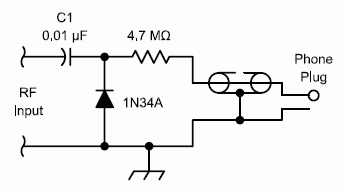Okay, after having read WB8ICN’s postings on QRPedia, I decided to try to measure the impedence of both of my meters. I dug a 1.5M ohm resistor out of the pile, and hooked some jumper leads to it. I then did the following:
- Measure the resistance of the resistor, using the DVM as an ohm meter (R)
- Measure the voltage of a 9 volt battery, using the DVM as a volt meter. (V)
- Hook the resistor in series with the battery, and measure the resulting voltage. (Vm)
What we are looking for is the resistance of the meter, which we will call Rm. A little math should show that Rm = R * Vm / (V – Vm). Okay, that heavy lifting aside, let’s see what we discovered about my two meters:
For my better meter, a nice Radio Shack PC interfaceable multimeter, I got the following readings:
- R = 1.496M ohms
- V = 9.24 volts
- Vm = 7.94 volts
Plugging these values into the formula, we get a value for Rm of 9.18M ohms, considerably off from the 10M ohms that we used as the “nominal” value. Later, I’ll go back and work up the correction factor for the previous nights example, but for now, let’s move onto my second meter, a cheapy $20 one that I’ve used mostly to check my car battery and continuity. I recorded the following values:
- R = 1.480M ohms
- V = 9.14 volts
- Vm = 3.68 volts
Plugging these values in, I get about .997M ohms, or about 1Mohm! No wonder my previous readings were so crazy, with the 4.4M ohm resistance of my series resistors, this thing was dividing the peak value down considerably.
Okay, let’s go back to my dummy load experiment. First, on meter number one, we find that Rm of 9.18M ohms. If we go through my various calculations and correct for the measured values, we find that the output power should be around 4.71 watts. Doing the same for measurement number two, we’d get an output power of around 4.67 watts, both in excellent agreement!
(Note, I didn’t measure the voltage drop of the diode, I’m assuming 0.7 v. The data sheet says the maximum drop would be 1v).
